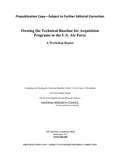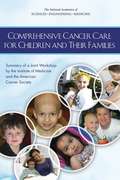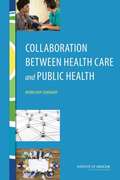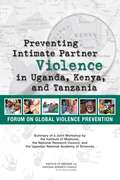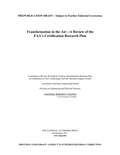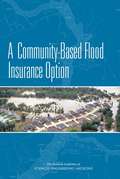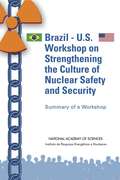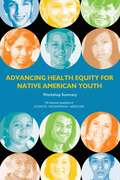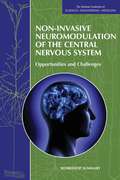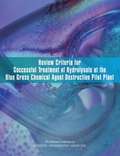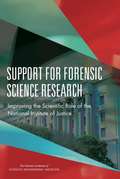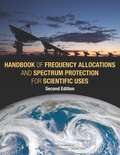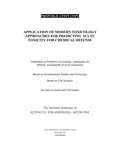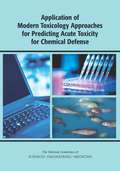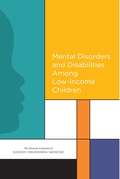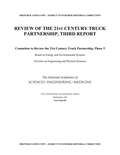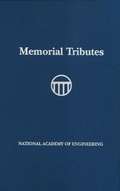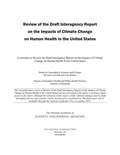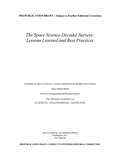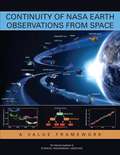- Table View
- List View
Owning the Technical Baseline for Acquisition Programs in the U.S. Air Force: A Workshop Report
by Committee on Owning the Technical Baseline in the U.S. Air Force: A WorkshopThe U.S. Air Force has experienced many acquisition program failures - cost overruns, schedule delays, system performance problems, and sustainability concerns - over program lifetimes. A key contributing factor is the lack of sufficient technical knowledge within the Air Force concerning the systems being acquired to ensure success.
Mathematics Curriculum, Teacher Professionalism, and Supporting Policies in Korea and the United States: Summary of a Workshop
by Ana FerrerasOn July 15-17, 2012 the United States National Commission on Mathematics Instruction and Seoul National University held a joint Korea-U. S. workshop on Mathematics Teaching and Curriculum. The workshop was organized to address questions and issues related to math teaching and curriculum that were generated by each country, including the following: What are the main concerns in the development of the curriculum? What issues have been discussed or debated among curriculum developers, teachers, teacher educators, and scholars regarding the curriculum? How have textbooks been developed for the curriculum? How are curricular tasks designed and what criteria are used? What is the role of learning trajectories in the development of curriculum? This report summarizes the presentations and discussions at the workshop.
Comprehensive Cancer Care for Children and Their Families: Summary of a Joint Workshop by the Institute of Medicine and the American Cancer Society
by Sharyl J. NassChildhood cancer is an area of oncology that has seen both remarkable progress as well as substantial continuing challenges. While survival rates for some pediatric cancers present a story of success, for many types of pediatric cancers, little progress has been made. Many cancer treatments are known to cause not only significant acute side effects, but also lead to numerous long-term health risks and reduced quality of life. Even in cases where the cancer is considered curable, the consequences of treatment present substantial long-term health and psychosocial concerns for children, their families, their communities, and our health system. To examine specific opportunities and suggestions for driving optimal care delivery supporting survival with high quality of life, the National Cancer Policy Forum of the Institute of Medicine and the American Cancer Society co-hosted a workshop which convened experts and members of the public on March 9 and 10, 2015. At this workshop, clinicians and researchers in pediatric oncology, palliative, and psychosocial care, along with representatives from the U. S. Food and Drug Administration, National Cancer Institute, Children's Oncology Group, pharmaceutical companies, and patient advocacy organizations, discussed and developed a menu of options for action to improve research, quality of care, and outcomes for pediatric cancer patients and their families. In addition, parents of children with cancer and pediatric cancer survivors shared their experiences with care and provided poignant personal perspectives on specific quality of life concerns and support needs for children and families across the life spectrum. This report summarizes the presentations and discussion of the workshop.
Comprehensive Cancer Care for Children and Their Families: Summary of a Joint Workshop by the Institute of Medicine and the American Cancer Society
by Sharyl J. NassChildhood cancer is an area of oncology that has seen both remarkable progress as well as substantial continuing challenges. While survival rates for some pediatric cancers present a story of success, for many types of pediatric cancers, little progress has been made. Many cancer treatments are known to cause not only significant acute side effects, but also lead to numerous long-term health risks and reduced quality of life. Even in cases where the cancer is considered curable, the consequences of treatment present substantial long-term health and psychosocial concerns for children, their families, their communities, and our health system. To examine specific opportunities and suggestions for driving optimal care delivery supporting survival with high quality of life, the National Cancer Policy Forum of the Institute of Medicine and the American Cancer Society co-hosted a workshop which convened experts and members of the public on March 9 and 10, 2015. At this workshop, clinicians and researchers in pediatric oncology, palliative, and psychosocial care, along with representatives from the U. S. Food and Drug Administration, National Cancer Institute, Children's Oncology Group, pharmaceutical companies, and patient advocacy organizations, discussed and developed a menu of options for action to improve research, quality of care, and outcomes for pediatric cancer patients and their families. In addition, parents of children with cancer and pediatric cancer survivors shared their experiences with care and provided poignant personal perspectives on specific quality of life concerns and support needs for children and families across the life spectrum. This report summarizes the presentations and discussion of the workshop.
Collaboration Between Health Care and Public Health: Workshop Summary
by Institute of Medicine Board on Population Health and Public Health Practice Roundtable on Population Health ImprovementOn February 5, 2015, the Institute of Medicine Roundtable on Population Health Improvement hosted a workshop to explore the relationship between public health and health care, including opportunities, challenges, and practical lessons. The workshop was convened in partnership with the Association of State and Territorial Health Officials (ASTHO)-Supported Primary Care and Public Health Collaborative. Organized in response to the 2012 IOM report Primary Care and Public Health: Exploring Integration to Improve Population Health, this workshop focused on current issues at the interface of public health and health care, including opportunities presented by and lessons learned from the Centers for Medicaid and Medicare Services State Innovation Models program. The workshop featured presentations on several dimensions of the public health-health care relationship. Collaboration Between Health Care and Public Health summarizes the presentations and discussion of the event.
Preventing Intimate Partner Violence in Uganda, Kenya, and Tanzania: Summary of a Joint Workshop by the Institute of Medicine, the National Research Council, and the Uganda National Academy of Sciences
by Louise FlavahanGlobally, between 15-71 percent of women will experience physical and/or sexual abuse from an intimate partner at some point in their lifetime. <P><P>Too often this preventable form of violence is repetitive in nature, occurring at multiple points across the lifespan. The prevalence of intimate partner violence is on the higher end of this spectrum in East Africa, with in-country demographic and health surveys indicating that approximately half of all women between the ages of 15-49 in Uganda, Kenya, and Tanzania having experienced physical or sexual abuse within a partnership. It is now widely accepted that preventing intimate partner violence is possible and can be achieved through a greater understanding of the problem; its risk and protective factors; and effective evidence-informed primary, secondary, and tertiary prevention. To that end, on August 11-12, 2014, the Institute of Medicine's Forum on Global Violence Prevention, in a collaborative partnership with the Uganda National Academy of Sciences, convened a workshop focused on informing and creating synergies within a diverse community of researchers, health workers, and decision makers committed to promoting intimate partner violence-prevention efforts that are innovative, evidence-based, and crosscutting. This workshop brought together a variety of stakeholders and community workers from Uganda, Kenya, and Tanzania to engage in a meaningful, multidirectional dialogue regarding intimate partner violence in the region. "Preventing Intimate Partner Violence in Uganda, Kenya, and Tanzania" summarizes the presentations and discussion of the workshop.
Transformation in the Air: A Review of the FAA's Certification Research Plan
by Committee to Review the Federal Aviation Administration Research Plan on Certification of New Technologies into the National Airspace SystemThe Federal Aviation Administration (FAA) is currently undertaking a broad program known as Next Generation Air Transportation System (NextGen) to develop, introduce, and certify new technologies into the National Airspace System. NextGen is a fundamentally transformative change that is being implemented incrementally over a period of many years. Currently, the FAA is putting into place the foundation that provides support for the future building blocks of a fully operational NextGen. NextGen is a challenging undertaking that includes ground systems, avionics installed in a wide range of aircraft, and procedures to take advantage of the new technology. "Transformation in the Air" assesses the FAA's plan for research on methods and procedures to improve both confidence in and the timeliness of certification of new technologies for their introduction into the National Airspace System. This report makes recommendations to include both ground and air elements and document the plan's relationship to the other activities and procedures required for certification and implementation into the National Airspace System.
A Community-Based Flood Insurance Option
by Committee on Community-Based Flood Insurance OptionsRiver and coastal floods are among the nation's most costly natural disasters. One component in the nation's approach to managing flood risk is availability of flood insurance policies, which are offered on an individual basis primarily through the National Flood Insurance Program (NFIP). Established in 1968, the NFIP is overseen by the Federal Emergency Management Agency (FEMA) and there are about 5. 4 million individual policies in the NFIP. The program has experienced a mixture of successes and persistent challenges. Successes include a large number of policy holders, the insurance of approximately $1. 3 trillion of property, and the fact that the large majority of policy holders - 80% - pay rates that are risk based. NFIP challenges include large program debt, relatively low rates of purchase in many flood-prone areas, a host of issues regarding affordability of premiums, ensuring that premiums collected cover payouts and administrative fees, and a large number of properties that experience severe repetitive flood losses. At the request of FEMA, "A Community-Based Flood Insurance Option" identifies a range of key issues and questions that would merit consideration and further analysis as part of a community-based flood insurance program. As the report describes, the community-based option certainly offers potential benefits, such as the prospect of providing coverage for all (or nearly all) at-risk residents and properties in flood-prone communities. At the same time, many current challenges facing the NFIP may not necessarily be resolved by a community-based approach. This report discusses these and other prominent issues to be considered and further assessed.
Brazil-U.S. Workshop on Strengthening the Culture of Nuclear Safety and Security: Summary of a Workshop
by Benjamin RusekOn August 25-26, 2014, the Instituto de Pesquisas Energéticas e Nucleares (IPEN) and the National Research Council of the U. S. National Academy of Sciences convened the Brazil-U. S. <P><P>Workshop on Strengthening the Culture of Nuclear Safety and Security. The workshop, held on the IPEN Campus in São Paulo, Brazil, examined how a culture of nuclear safety and security is built and maintained within the nuclear science, technology, and industrial sectors. Participants identified opportunities for cooperation to strengthen that culture and shared research, perspectives, and practices. This report summarizes the presentation and discussion of that event.
Interim Report on 21st Century Cyber-Physical Systems Education
by Committee on 21st Century Cyber-Physical Systems EducationCyber-physical systems (CPS) are increasingly relied on to provide the functionality and value to products, systems, and infrastructure in sectors including transportation, health care, manufacturing, and electrical power generation and distribution. CPS are smart, networked systems with embedded sensors, computer processors, and actuators that sense and interact with the physical world; support real-time, guaranteed performance; and are often found in critical applications. Cyber-physical systems have the potential to provide much richer functionality, including efficiency, flexibility, autonomy, and reliability, than systems that are loosely coupled, discrete, or manually operated, but also can create vulnerability related to security and reliability. Advances in CPS could yield systems that can communicate and respond faster than humans; enable better control and coordination of large-scale systems, such as the electrical grid or traffic controls; improve the efficiency of systems; and enable advances in many areas of science. As CPS become more pervasive, so too will demand for a workforce with the capacity and capability to design, develop, and maintain them. Building on its research program in CPS, the National Science Foundation (NSF) has begun to explore requirements for education and training. As part of that exploration, NSF asked the National Research Council of the National Academies to study the topic. Two workshops were convened in 2014, on April 30 and October 2-3 in Washington, D. C. , to explore the knowledge and skills required for CPS work, education, and training requirements and possible approaches to retooling engineering and computer science programs and curricula to meet these needs. "Interim Report on 21st Century Cyber-Physical Systems Education" highlights emerging themes and summarizes related discussions from the workshops.
Advancing Health Equity for Native American Youth: Workshop Summary
by National Academies of Sciences Engineering MedicineMore than 2 million Americans below age 24 self-identify as being of American Indian or Alaska Native descent. Many of the serious behavioral, emotional, and physical health concerns facing young people today are especially prevalent with Native youth (e.g., depression, violence, and substance abuse). Adolescent Native Americans have death rates two to five times the rate of whites in the same age group because of higher levels of suicide and a variety of risky behaviors (e.g., drug and alcohol use, inconsistent school attendance). Violence, including intentional injuries, homicide, and suicide, accounts for three-quarters of deaths for Native American youth ages 12 to 20. Suicide is the second leading cause of death—and 2.5 times the national rate—for Native youth ages 15 to 24. Arrayed against these health problems are vital cultural strengths on which Native Americans can draw. At a workshop held in 2012, by the National Academies of Sciences, Engineering, and Medicine, presenters described many of these strengths, including community traditions and beliefs, social support networks, close-knit families, and individual resilience. In May 2014, the Academies held a follow-up workshop titled Advancing Health Equity for Native American Youth. Participants discussed issues related to (1) the visibility of racial and ethnic disparities in health and health care as a national problem, (2) the development of programs and strategies by and for Native and Indigenous communities to reduce disparities and build resilience, and (3) the emergence of supporting Native expertise and leadership. This report summarizes the presentations and discussions from the workshop.
Non-Invasive Neuromodulation of the Central Nervous System: Workshop Summary
by Lisa BainBased on advances in biotechnology and neuroscience, non-invasive neuromodulation devices are poised to gain clinical importance in the coming years and to be of increasing interest to patients, clinicians, health systems, payers, and industry. Evidence suggests that both therapeutic and non-therapeutic applications of non-invasive neuromodulation will continue to expand in coming years, particularly for indications where treatments are currently insufficient, such as drug-resistant depression. Given the growing interest in non-invasive neuromodulation technologies, the Institute of Medicine's Forum on Neuroscience and Nervous System Disorders convened a workshop, inviting a range of stakeholders - including developers of devices and new technologies, researchers, clinicians, ethicists, regulators, and payers - to explore the opportunities, challenges, and ethical questions surrounding the development, regulation, and reimbursement of these devices for the treatment of nervous system disorders as well as for non-therapeutic uses, including cognitive and functional enhancement. This report highlights the presentation and discussion of the workshop.
Review Criteria for Successful Treatment of Hydrolysate at the Blue Grass Chemical Agent Destruction Pilot Plant
by Committee on Review Criteria for Successful Treatment of Hydrolysate at the Pueblo Blue Grass Chemical Agent Destruction Pilot PlantsIn 1993, the United States signed the Chemical Weapons Convention (CWC), an international treaty outlawing the production, stockpiling, and use of chemical weapons. The chemical weapons stockpiles at five of the U. S. chemical weapons storage sites have now been destroyed. At those sites, the munitions were robotically opened and the chemical agent was removed, collected, and incinerated. One of the remaining sites with chemical weapons stockpiles is the Blue Grass Army Depot near Richmond, Kentucky. In this case, caustic hydrolysis will be used to destroy the agents and energetics, resulting in a secondary waste stream known as hydrolysate. "Review Criteria for Successful Treatment of Hydrolysate at the Blue Grass Chemical Agent Destruction Pilot Plant" develops criteria for successfully treating the hydrolysate, identifies systemization data that should factor into the criteria/decision process, suggests potential modifications to suggested treatment that would allow continued onsite processing, and assesses waste disposal procedures. This study further examines the possibility of delay or failure of the existing technology and examines possible alternatives to onsite treatment.
Support for Forensic Science Research: Improving the Scientific Role of the National Institute of Justice
by Committee on Strengthening Forensic Science at the National Institute of JusticeReliable and valid forensic science analytic techniques are critical to a credible, fair, and evidence-based criminal justice system. There is widespread agreement that the scientific foundation of some currently available forensic science methods needs strengthening and that additional, more efficient techniques are urgently needed. These needs can only be met through sustained research programs explicitly designed to ensure and improve the reliability and validity of current methods and to foster the development and use of new and better techniques. This task is challenging due to the broad nature of the field. Concerns have been raised repeatedly about the ability of the criminal justice system to collect and analyze evidence efficiently and to be fair in its verdicts. Although significant progress has been made in some forensic science disciplines, the forensic science community still faces many challenges. Federal leadership, particularly in regard to research and the scientific validation of forensic science methods, is needed to help meet the pressing issues facing state and local jurisdictions. This report reviews the progress made by the National Institute of Justice (NIJ) to advance forensic science research since the 2009 report, Strengthening Forensic Science in the United States: A Path Forward and the 2010 report, Strengthening the National Institute of Justice. Support for Forensic Science Research examines the ways in which NIJ develops its forensic science research priorities and communicates those priorities as well as its findings to the scientific and forensic practitioner communities in order to determine the impact of NIJ forensic science research programs and how that impact can be enhanced.
Handbook of Frequency Allocations and Spectrum Protection for Scientific Uses: Second Edition
by Panel on Frequency Allocations Spectrum Protection for Scientific UsesThe electromagnetic spectrum is a vital part of our environment. Measures of radio frequency emissions from natural phenomena enable both practical applications, such as weather predictions and studies of the changing of Earth's climate here at home, and reveal the physical properties of cosmic sources. The spectrum is therefore a resource to be used wisely now and to be protected for future generations. "Handbook of Frequency Allocations and Spectrum Protection for Scientific Uses: Second Edition" sets forth the principles for the allocation and protection of spectral bands for services using the radio spectrum for scientific research. This report describes the radio frequency bands used by scientific services and includes relevant regulatory information and discussion of scientific use of frequency bands. This reference will guide spectrum managers and spectrum regulatory bodies on science issues and serve as a resource to scientists and other spectrum users.
Application of Modern Toxicology Approaches for Predicting Acute Toxicity for Chemical Defense
by Committee on Predictive-Toxicology Approaches for Military Assessments of Acute ExposuresThe US Department of Defense (DOD) is faced with an overwhelming task in evaluating chemicals that could potentially pose a threat to its deployed personnel. There are over 84,000 registered chemicals, and testing them with traditional toxicity-testing methods is not feasible in terms of time or money. In recent years, there has been a concerted effort to develop new approaches to toxicity testing that incorporate advances in systems biology, toxicogenomics, bioinformatics, and computational toxicology. Given the advances, DOD asked the National Research Council to determine how DOD could use modern approaches for predicting chemical toxicity in its efforts to prevent debilitating, acute exposures to deployed personnel. This report provides an overall conceptual approach that DOD could use to develop a predictive toxicology system. "Application of Modern Toxicology Approaches for Predicting Acute Toxicity for Chemical Defense" reviews the current state of computational and high-throughput approaches for predicting acute toxicity and suggests methods for integrating data and predictions. This report concludes with lessons learned from current high-throughput screening programs and suggests some initial steps for DOD investment.
Application of Modern Toxicology Approaches for Predicting Acute Toxicity for Chemical Defense
by Committee on Predictive-Toxicology Approaches for Military Assessments of Acute ExposuresThe US Department of Defense (DOD) is faced with an overwhelming task in evaluating chemicals that could potentially pose a threat to its deployed personnel. There are over 84,000 registered chemicals, and testing them with traditional toxicity-testing methods is not feasible in terms of time or money. In recent years, there has been a concerted effort to develop new approaches to toxicity testing that incorporate advances in systems biology, toxicogenomics, bioinformatics, and computational toxicology. Given the advances, DOD asked the National Research Council to determine how DOD could use modern approaches for predicting chemical toxicity in its efforts to prevent debilitating, acute exposures to deployed personnel. This report provides an overall conceptual approach that DOD could use to develop a predictive toxicology system. "Application of Modern Toxicology Approaches for Predicting Acute Toxicity for Chemical Defense" reviews the current state of computational and high-throughput approaches for predicting acute toxicity and suggests methods for integrating data and predictions. This report concludes with lessons learned from current high-throughput screening programs and suggests some initial steps for DOD investment.
Mental Disorders and Disabilities Among Low-Income Children
by Thomas F. BoatChildren living in poverty are more likely to have mental health problems, and their conditions are more likely to be severe. Of the approximately 1. 3 million children who were recipients of Supplemental Security Income (SSI) disability benefits in 2013, about 50% were disabled primarily due to a mental disorder. An increase in the number of children who are recipients of SSI benefits due to mental disorders has been observed through several decades of the program beginning in 1985 and continuing through 2010. Nevertheless, less than 1% of children in the United States are recipients of SSI disability benefits for a mental disorder. At the request of the Social Security Administration, "Mental Disorders and Disability Among Low-Income Children" compares national trends in the number of children with mental disorders with the trends in the number of children receiving benefits from the SSI program, and describes the possible factors that may contribute to any differences between the two groups. This report provides an overview of the current status of the diagnosis and treatment of mental disorders, and the levels of impairment in the U. S. population under age 18. The report focuses on 6 mental disorders, chosen due to their prevalence and the severity of disability attributed to those disorders within the SSI disability program: attention-deficit/hyperactivity disorder, oppositional defiant disorder/conduct disorder, autism spectrum disorder, intellectual disability, learning disabilities, and mood disorders. While this report is not a comprehensive discussion of these disorders, "Mental Disorders and Disability Among Low-Income Children" provides the best currently available information regarding demographics, diagnosis, treatment, and expectations for the disorder time course - both the natural course and under treatment.
Health Literacy and Consumer-Facing Technology: Workshop Summary
by Joe AlperThe proliferation of consumer-facing technology and personal health information technology has grown steadily over the past decade, and has certainly exploded over the past several years. Many people have embraced smartphones and wearable health-monitoring devices to track their fitness and personal health information. Providers have made it easier for patients and caregivers to access health records and communicate through online patient portals. However, the large volume of health-related information that these devices can generate and input into a health record can also lead to an increased amount of confusion on the part of users and caregivers. The Institute of Medicine convened a workshop to explore health literate practices in health information technology and then provide and consider the ramifications of this rapidly growing field on the health literacy of users. Health Literacy and Consumer-Facing Technology summarizes the discussions and presentations from this workshop, highlighting the lessons presented, practical strategies, and the needs and opportunities for improving health literacy in consumer-facing technology.
Examining a Developmental Approach to Childhood Obesity: Workshop Summary
by Leslie A. PrayRecent scientific evidence points to the origins of childhood obesity as an outcome of the dynamic interplay of genetic, behavioral, and environmental factors throughout early development, with a compelling body of evidence suggesting that both maternal and paternal nutritional and other exposures affect a child's risk of later obesity. The burgeoning field of epigenetics has led researchers to speculate that many of the observed associations between early developmental exposures and later risk of childhood obesity are mediated, at least in part, through epigenetic mechanisms. To explore the body of evolving science that examines the nexus of biology, environment, and developmental stage on risk of childhood obesity, the Institute of Medicine and the National Research Council convened a workshop in February 2015. The workshop focused on the prenatal period, infancy, and early childhood and addressed evidence from both animal and human studies. Workshop objectives were to (1) identify epigenetic-mediated relationships between exposure to risk factors during sensitive periods of development (gestation through age 3) and subsequent obesity-related outcomes; (2) explore the science around periods of plasticity and potential reversibility of obesity risk in the context of early childhood development; and (3) examine the translation of epigenetic science to guide early childhood obesity prevention and intervention to reduce obesity risk. This report summarizes the information presented and discussed at the workshop.
Review of the 21st Century Truck Partnership: Third Report
by Committee to Review the 21st Century Truck Partnership Phase 3The 21st Century Truck Partnership (21CTP) works to reduce fuel consumption and emissions, increase heavy-duty vehicle safety, and support research, development, and demonstration to initiate commercially viable products and systems. This report is the third in a series of three by the National Academies of Sciences, Engineering, and Medicine that have reviewed the research and development initiatives carried out by the 21CTP. "Review of the 21st Century Truck Partnership, Third Report" builds on the Phase 1 and 2 reviews and reports, and also comments on changes and progress since the Phase 2 report was issued in 2012.
Memorial Tributes: Volume 14
by National Academy of EngineeringThis is the fourteenth volume in the series of Memorial Tributes compiled by the National Academy of Engineering as a personal remembrance of the lives and outstanding achievements of its members and foreign associates. These volumes are intended to stand as an enduring record of the many contributions of engineers and engineering to the benefit of humankind. In most cases, the authors of the tributes are contemporaries or colleagues who had personal knowledge of the interests and the engineering accomplishments of the deceased.
Review of the Draft Interagency Report on the Impacts of Climate Change on Human Health in the United States
by National Academies of Science Engineering MedicineThe U.S. National Climate Assessment (NCA; Melillo et al., 2014) identified a number of ways in which climate change is affecting or is likely to affect, people, infrastructure, natural resources, and ecosystems. Those impacts in turn have the potential for important current and future consequences for human health. Research on these impacts is active, with strong evidence to support some aspects and research still in progress for others. Therefore, there is a need to assess our understanding of how the impacts of climate change on the environment can create stressors that can affect human health in a number of dimensions both now and in the future. <P> In response to this need, the U.S. Global Change Research Program (USGCRP) has initiated an interagency Assessment on the Impacts of Climate Change on Human Health in the United States. The Assessment is intended to inform public health authorities, other planning and policy entities, and the general public. It extends the work begun under the 2008 Synthesis and Assessment Product 4.6 (USGCRP, 2008) Analyses of the Effects of Global Change on Human Health and Welfare and Human Systems and the third NCA released in 2014.
The Space Science Decadal Surveys: Lessons Learned and Best Practices
by Committee on Survey of Surveys: Lessons Learned from the Decadal Survey ProcessThe National Research Council has conducted 11 decadal surveys in the Earth and space sciences since 1964 and released the latest four surveys in the past 8 years. The decadal surveys are notable in their ability to sample thoroughly the research interest, aspirations, and needs of a scientific community. Through a rigorous process, a primary survey committee and thematic panels of community members construct a prioritized program of science goals and objectives and define an executable strategy for achieving them. These reports play a critical role in defining the nation's agenda in that science area for the following 10 years, and often beyond. "The Space Science Decadal Surveys" considers the lessons learned from previous surveys and presents options for possible changes and improvements to the process, including the statement of task, advanced preparation, organization, and execution. This report discusses valuable aspects of decadal surveys that could taken further, as well as some challenges future surveys are likely to face in searching for the richest areas of scientific endeavor, seeking community consensus of where to go next, and planning how to get there. "The Space Science Decadal Surveys" describes aspects in the decadal survey prioritization process, including balance in the science program and across the discipline; balance between the needs of current researchers and the development of the future workforce; and balance in mission scale - smaller, competed programs versus large strategic missions.
Continuity of NASA Earth Observations from Space: A Value Framework
by Committee on a Framework for Analyzing the Needs for Continuity of NASA-Sustained Remote Sensing Observations of the Earth from SpaceNASA's Earth Science Division (ESD) conducts a wide range of satellite and suborbital missions to observe Earth's land surface and interior, biosphere, atmosphere, cryosphere, and oceans as part of a program to improve understanding of Earth as an integrated system. Earth observations provide the foundation for critical scientific advances and environmental data products derived from these observations are used in resource management and for an extraordinary range of societal applications including weather forecasts, climate projections, sea level change, water management, disease early warning, agricultural production, and the response to natural disasters. As the complexity of societal infrastructure and its vulnerability to environmental disruption increases, the demands for deeper scientific insights and more actionable information continue to rise. To serve these demands, NASA's ESD is challenged with optimizing the partitioning of its finite resources among measurements intended for exploring new science frontiers, carefully characterizing long-term changes in the Earth system, and supporting ongoing societal applications. This challenge is most acute in the decisions the Division makes between supporting measurement continuity of data streams that are critical components of Earth science research programs and the development of new measurement capabilities. This report seeks to establish a more quantitative understanding of the need for measurement continuity and the consequences of measurement gaps. Continuity of NASA's Earth's Observations presents a framework to assist NASA's ESD in their determinations of when a measurement or dataset should be collected for durations longer than the typical lifetimes of single satellite missions.
